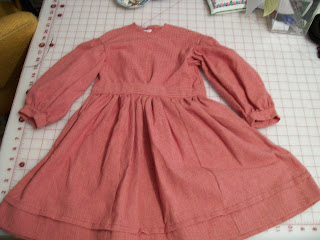This is an easy and versatile pattern, and if you need to make 1850s/60s baby clothes, you should buy it. As with the girls' dresses pattern, there's many different customization options: three bodices (five,counting the high/low options), 4-5 base sleeves, waist treatment options, etc. In fact, it's basically the same pattern, only sized for infants instead of girls & pre-teens. The main difference is that the infant pattern includes a straight long sleeve instead of a coat sleeve option In theory, you could get one pattern or the other and simply size up or down as needed--but then, in theory, you could also drape instead of using a pattern at all. Also included in the pattern booklet is specific discussion of long versus short infant skirts (for mobile versus stationary babies); fabric choice, yardage calculations, and trim options are also explored.
Undergarments and outwear are available in separate patterns. All HMP/SA infant patterns are unisex.
Since I'm making clothes to fill gaps in a lending wardrobe, I made up the dress pattern as-is, in the three larger sizes--they'll be getting altered for every wearer anyway, so tucks and waistbands were used. As noted before, it would be nice if suggested skirt width/lengths pairings were included for those without a good grasp on how wide a skirt should be for a wearer of a given stature. I imagine this is easier if one has a model on-hand and can experiment a little. Nonetheless, the instructions are very thorough for making skirts to measure and the smaller range of infant sizes made it easier to guess where on the width range a given garment should fall.
There is an error in the pattern copy I was working from, in that coat sleeve instructions are included, but the long, straight sleeve is not (however, it makes up fine following the short straight sleeve instructions). This may have been fixed in newer copies. On the size B jewel-neck bodice, I'm concerned that the neck line is disproportionately small, and will be looking into it (if sewing for a specific child, a toile/mock-up would have solved this problem at the beginning--make a toile!).
What You Get: Pattern Book, 1 page of bodice and sleeve pattern pieces on printer-weight paper (skirts/cuffs/bindings, being rectangles, have cutting instructions rather than printed pattern pieces).
What You Need: Fabric; thread; hooks and eyes or buttons; cording and twill tape (for some styles); sewing tools
Score: Five Stars
Difficulty: Beginner and up. As in other SA patterns, there's an illustrated explanation of period sewing techniques included, putting this pattern within the reach of even the most novice of sewers. I'm told that those less mathematically-inclined still find them a little challenging, but the designer's accompanying on-line advice forum can help. The small pieces in this pattern make some parts easier to sew by hand than on machine.
Accuracy: Very High.
Strongest Impression: A versatile and accurate pattern that goes together quickly.







